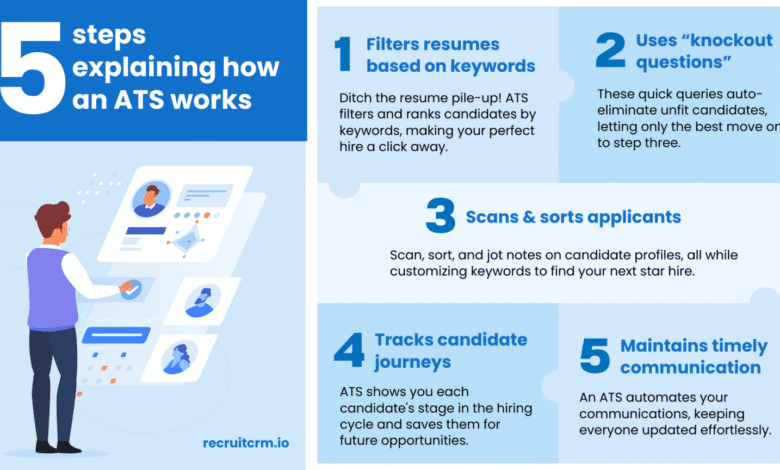Applicant Tracking Systems: The Ultimate Guide to Creating an ATS-Optimized CV in 2025

Applicant Tracking Systems: The Ultimate Guide to Creating an ATS-Optimized CV in 2025
Introduction
In today’s competitive job market, submitting a well-crafted CV isn’t enough. Did you know that over 98% of Fortune 500 companies and countless small to mid-sized businesses use Applicant Tracking Systems (ATS) to filter job applications? If your CV isn’t optimized for ATS, it might never reach a human recruiter—no matter how qualified you are. This guide will walk you through everything you need to know about ATS and how to create a CV that passes the automated screening and lands you interviews.
What is an Applicant Tracking System (ATS)?
An ATS is software used by employers to manage recruitment workflows, from job postings to applicant tracking and onboarding. It acts as a database for resumes, automates repetitive tasks, and helps recruiters filter candidates based on specific criteria. Key functionalities include:
- Resume Parsing: Extracting details like work experience, skills, and education from resumes.
- Keyword Filtering: Scanning for keywords relevant to the job description.
- Automated Screening: Using “knockout questions” to eliminate candidates who don’t meet minimum requirements (e.g., years of experience or certifications) .
Why ATS Optimization Matters for Your CV
- ATS as the Gatekeeper:
- Recruiters use ATS to search for candidates using keywords. If your CV lacks these keywords, it may never appear in search results, even if you’re highly qualified .
- Studies show that resumes tailored to ATS requirements receive 10.6 times more interviews than generic ones 2.
- Efficiency for Employers:
- ATS saves time by automating tasks like interview scheduling and communication, but it also means your CV must be machine-readable to get noticed 17.
How to Create an ATS-Optimized CV
1. Use Keywords Strategically
- Identify Relevant Keywords: Analyze the job description for repeated skills, qualifications, and job-specific terms (e.g., “project management,” “Python,” “Google Analytics”).
- Incorporate Keywords Naturally: Include them in your summary, work experience, and skills sections. Avoid “keyword stuffing,” which can flag your CV as spam .
- Use Both Acronyms and Full Terms: For example, “Enterprise Resource Planning (ERP)” ensures you match searches for both versions .
2. Choose an ATS-Friendly Format
- Simple Layouts: Avoid tables, columns, graphics, or unusual fonts. Stick to a clean, reverse-chronological format .
- Standard Section Headings: Use common titles like “Work Experience,” “Education,” and “Skills” instead of creative labels .
- File Type: Save your CV as a Word document (.docx) or PDF unless otherwise specified .
3. Optimize Content for Readability
- Action Verbs: Start bullet points with verbs like “managed,” “developed,” or “optimized” to highlight achievements .
- Quantify Results: Use metrics to demonstrate impact (e.g., “increased sales by 20%”) .
- Concise Language: Keep your CV to one page if possible, and use clear, straightforward language
4. Avoid Common ATS Pitfalls
- Headers/Footers: Important details like contact information may be ignored if placed in headers or footers 914.
- Unreadable Fonts: Use ATS-friendly fonts like Arial, Calibri, or Georgia (size 10–12 pt) .
- Graphics and Tables: These can confuse ATS software and cause parsing errors .
5. Tailor Your CV for Each Job
- Customize your CV for every application by mirroring the language and requirements of the job description. Tools like Jobscan’s resume scanner can help you compare your CV to job postings and identify missing keywords .
6. Include Critical Sections
- Contact Information: Place your name, phone number, email, and LinkedIn URL at the top .
- Skills Section: List hard skills (e.g., software proficiency) and soft skills (e.g., leadership) separately .
- Job Title Alignment: Include the exact job title you’re applying for in your resume headline or summary .
The Future of ATS
ATS technology is evolving with AI integration, which may soon predict candidate success based on experience and reduce biases in hiring. Video resumes and enhanced analytics are also on the horizon . Staying updated on these trends can give you a competitive edge.
FAQ
Q1: How can I check if my CV is ATS-friendly?
Use online tools like Jobscan or Teal’s resume checker to analyze keyword alignment and formatting issues .
Q2: Does ATS reject candidates?
No. ATS ranks and filters candidates based on keywords and criteria set by recruiters. It doesn’t automatically reject resumes .
Q3: Should I use a creative CV design?
Avoid overly designed CVs. Simplicity is key for ATS parsing. Save creativity for industries like design, where portfolios matter more .
Conclusion
Optimizing your CV for ATS is no longer optional—it’s essential for cutting through the digital noise and landing your dream job. By focusing on keywords, formatting, and tailoring your content, you’ll increase your chances of passing the automated screening and impressing human recruiters. Start refining your CV today, and watch your interview invitations soar!
Call to Action:
Need help optimizing your CV? Try tools like Jobscan or Teal’s AI Resume Builder for personalized suggestions. For more job search tips, subscribe to our newsletter!
Hashtags: #ATS #JobSearch #CVTips #CareerAdvice #ResumeWriting #HRTech #JobInterviews

